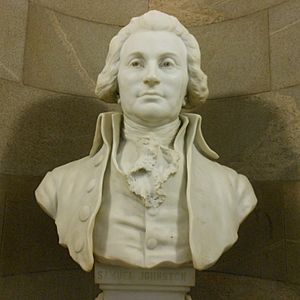Samuel Johnston facts for kids
Quick facts for kids
Samuel Johnston
|
|
|---|---|
 |
|
| United States Senator from North Carolina |
|
| In office November 26, 1789 – March 4, 1793 |
|
| Preceded by | None |
| Succeeded by | Alexander Martin |
| 6th Governor of North Carolina | |
| In office December 20, 1787 – December 17, 1789 |
|
| Preceded by | Richard Caswell |
| Succeeded by | Alexander Martin |
| 1st and 3rd Grand Master of the Masons of North Carolina |
|
| In office 1787–1788 |
|
| Preceded by | Office established |
| Succeeded by | Richard Caswell |
| In office 1789–1792 |
|
| Preceded by | Richard Caswell |
| Succeeded by | William Richardson Davie |
| Acting Governor of North Carolina | |
| In office 1775 |
|
| Monarch | George III |
| Preceded by | Josiah Martin |
| Succeeded by | Richard Caswell |
| Personal details | |
| Born | December 15, 1733 Dundee, Scotland, Kingdom of Great Britain |
| Died | August 17, 1816 (aged 82) Edenton, North Carolina, U.S. |
| Political party | Federalist |
Samuel Johnston (born December 15, 1733 – died August 17, 1816) was an important American leader. He was a planter and a lawyer from Chowan County, North Carolina. Samuel Johnston represented North Carolina in the Continental Congress. He also served in the United States Senate. He was the sixth Governor of North Carolina.
Contents
Samuel Johnston: A North Carolina Leader
Early Life and the Road to Revolution
Samuel Johnston was born in Dundee, Scotland. This was part of the Kingdom of Great Britain at the time. When he was three years old, his family moved to America in 1736. His father, Samuel Sr., became a surveyor-general in the colony. Samuel Sr.'s brother, Gabriel Johnston, was the royal governor.
Young Samuel studied in New England. Later, he learned law in Carolina. He moved to Chowan County and started his own farm. This farm was called Hayes, near Edenton.
Johnston became a lawyer in Edenton. In 1759, he was chosen for the North Carolina House of Burgesses. This was like a local government assembly. He served there until 1775, when the American Revolution began.
During the Regulator Movement in 1770, he helped pass a law. This law was called the Johnston Riot Act. It was created after a riot in Hillsborough. This law made the Regulator movement grow even more. It led to a battle called the Battle of Alamance in 1771.
Johnston strongly supported American independence. He was chosen as a delegate for the first four provincial congresses. These were meetings where leaders discussed breaking away from Britain. He led the Third and Fourth congresses in 1775 and 1776. After the royal governor left in 1775, Johnston was the highest-ranking official. This was until Richard Caswell became president of the Fifth Provincial Congress.
A Role in Early American Government
North Carolina sent Samuel Johnston to the Continental Congress in 1780 and 1781. This was a group of delegates from the thirteen colonies. They met to make decisions for the new country. Johnston was chosen to be the first President of the United States in Congress Assembled. This was under the Articles of Confederation, which was the first constitution of the U.S.
However, Samuel Johnston decided not to take the job. He gave reasons that the other delegates accepted. So, they chose Thomas McKean instead.
Governor and Senator
Samuel Johnston served as Governor of North Carolina from 1787 to 1789. As governor, he led two important meetings. These meetings were held to decide if North Carolina would approve the new U.S. Constitution. In 1788, the first meeting rejected the Constitution, even though Johnston strongly supported it.
He called another meeting in 1789. This time, North Carolina voted to approve the Constitution. After this, Johnston stepped down as governor. He became one of North Carolina's first two U.S. Senators. He served in the Senate from 1789 to 1793.
In 1800, he became a Judge in the Superior Court of North Carolina. He held this job until he retired in 1803.
His Last Years and Legacy
Samuel Johnston passed away at his home in 1816. His home was called Hayes Plantation, near Edenton, in Chowan County. He is buried in the Johnston Burial Ground there. The plantation house is still privately owned today. It was named a National Historic Landmark in 1973. His son, James Cathcart Johnston, finished building the current house a year after Samuel's death.
Samuel Johnston loved books. He left his personal collection of books to his son James. Today, a full-size copy of the Hayes Plantation library is at the University of North Carolina at Chapel Hill. This special room is on display in the North Carolina Collection Gallery in Wilson Library.
See also
- List of U.S. state governors born outside the United States

